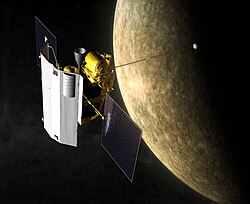EW1027346412Gnomap
This image was acquired as part of MDIS's limb imaging campaign. Once per week, MDIS captures images of Mercury's limb, with an emphasis on imaging the southern hemisphere limb. These limb images provide information about Mercury's shape and complement measurements of topography made by the Mercury Laser Altimeter (MLA) of Mercury's northern hemisphere.
The MESSENGER spacecraft is the first ever to orbit the planet Mercury, and the spacecraft's seven scientific instruments and radio science investigation are unraveling the history and evolution of the Solar System's innermost planet. During the first two years of orbital operations, MESSENGER acquired over 150,000 images and extensive other data sets. MESSENGER is capable of continuing orbital operations until early 2015.Relevantní obrázky
Relevantní články
Merkur (planeta)Merkur je Slunci nejbližší a současně i nejmenší planetou sluneční soustavy, dosahuje pouze 140 % velikosti zemského Měsíce a je menší než Jupiterův měsíc Ganymed a Saturnův Titan. Merkur nemá žádný měsíc. Jeho oběžná dráha je ze všech planet nejblíže ke Slunci a jeden oběh trvá pouze 87,969 dne. Dráha Merkuru má největší výstřednost dráhy ze všech planet sluneční soustavy a sama planeta má nejmenší – téměř nulový – sklon rotační osy. Během dvou oběhů kolem Slunce dojde ke třem otočením kolem rotační osy. Perihelium jeho dráhy se stáčí ke Slunci o 43 vteřin za století; fenomén, který ve 20. století vysvětlil Albert Einstein obecnou teorií relativity. Při pohledu ze Země dosahuje Merkur jasnosti mezi -2,0 až 5,5m, takže je viditelný i pouhým okem, ale jelikož se nikdy nevzdaluje od Slunce dále než na 28,3°, je většinu roku těžko pozorovatelný. Nejlepší podmínky nastávají při ranním a večerním soumraku, kdy se slunce nachází pod horizontem. .. pokračovat ve čtení

















